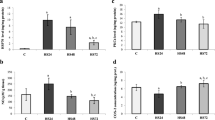Abstract
Recent reports suggest that delayed myocardial protection (“second window of preconditioning”) occurs 24 hours after brief ischemic or thermal stress. In order to test this hypothesis, we subjected New Zealand White rabbits to a heating regimen (42°C for 15–20 minutes). Twenty four hours later, the effect of heat stress on infarct size was determined by conducting a 30 minute ischemia/3 hour reperfusion protocol. In a separate group of rabbits, Western blot analysis was used to verify that the heating regimen increased expression of HSP72i. The size of the region at risk was delineated by infusion of Unisperse blue and infarcted myocardium was identified by incubation of left ventricular slices in triphenyl tetrazolium chloride. In contrast to expectations, induction of HSP72i with thermal stress was not effective in limiting infarct size in rabbits 24 hours later, calling into question the concept that heat stress induces delayed or “second window” myocardial protection.
Similar content being viewed by others
References
Benjamin IJ, Williams RS (1994) Expression and function of stress proteins in the ischemic heart. In: The Biology of Heat Shock Proteins and Molecular Chaperones, Cold Spring Harbor Laboratory Press, pp 533–553
Currie RW, Karmazyn M, Kloc M, Mailer K (1988) Heat shock response is associated with enhanced postischemic ventricular recovery. Circ Res 63: 543–549
Currie RW, Tanguay RM, Kingma JG Jr (1993) Heat-shock response and limitation of tissue necrosis during occlusion/reperfusion in rabbit hearts. Circulation 87: 963–971
Delcayre C, Samuel J-L, Marotte F, Best-Belpomme M, Mercadier JJ, Rappaport (1988) Synthesis of stress proteins in rat cardiac myocytes 2–4 days after imposition of hemodynamic overload. J Clin Invest 82: 460–468
Donnelly TJ, Sievers RE, Visern FLJ, Welch WJ, Wolfe CL (1992) Heat shock protein induction in rat hearts: a role for improved myocardial salvage after ischemia and reperfusion? Circulation 85: 769–778
Harken AH, Simson MB, Haselgrove J, Wetstein L, Harden WR, Barlow CH (1981) Early ischemia after complete coronary ligation in the rabbit, dog, pig, and monkey. Am J Physiol 241 (Heart Circ Physiol 10): H202-H210
Heads RJ, Baxter GF, Latchman DS, Yellon DM (1995) Delayed protection in rabbit heart following ischaemic preconditioning is associated with modulation of HSP27 and superoxide dismutase at 24 hours (abstract). J Mol Cell Cardiol 27: A163
Hutter JJ, Mestril R, Tam EKW, Sievers RE, Dillman WH, Wolfe CL (1996) Overexpression of heat shock protein 72 in transgenic mice decreases infarct size in vivo. Circulation 94: 1408–1411
Hutter MM, Sievers RE, Barbosa V, Wolfe CL (1994) Heat shock protein induction in rat hearts: A direct correlation between amount of heat shock protein induced and the degree of myocardial protection. Circulation 89: 355–360
Kuzuya T, Hoshida S, Yamashita N, Fuji H, Oe H, Hori M, Kamada T, Tada M (1993) Delayed effects of sublethal ischemia on the acquisition of tolerance to ischemia. Circ Res 72: 1293–1299
Laemmli UK (1970) Cleavage of structural proteins during the assembly of the head of bacteriophage T4. Nature 227: 680–685
Marber MS, Latchman DS, Walker JM, Yellon YM (1993) Cardiac stress protein elevation 24 hours after brief ischemia or heat stress is associated with resistance to myocardial infarction. Circulation 88: 1264–1272
Marber MS, Mestril R, Chi SH, Sayen MR, Yellon DM, Dillman WH (1995) Overexpression of the rat inducible 70-kD heat stress protein in a transgenic mouse increases the resistance of the heart to ischemic injury. J Clin Invest 95: 1446–1456
Maxwell MP, Hearse DJ, Yellon DM (1987) Species variation in the coronary collateral circulation during regional myocardial ischemia: a critical determinant of the rate of evolution and extent of myocardial infarction. Cardiovasc Res 21: 737–746
Miura T, Downey JM, Ooiwa H, Ogawa S, Adachi T, Noto T, Shizukuda Y, Iimura O (1989) Progression of myocardial infarction in a collateral flow deficient species. Jap Heart J 30: 695–708
Murry CE, Jennings RB, Reimer KA (1986) Preconditioning with ischemia: a delay of lethal cell injury in ischemic myocardium. Circulation 74: 1124–1136
Plumier JC, Ross BM, Currie RW, Angelidis CE, Kazlaris H, Kollias G, Pagoulatos GN (1995) Transgenic mice expressing the human heat shock protein 70 have improved postischemic myocardial recovery. J Clin Invest 95: 1854–1860
Qiu Y, Tang X-L, Sun J-Z, Park S-W, Kalya A, Bolli R (1995) Does the late phase of ischemic preconditioning protect against infarction and reperfusion arrythmias in conscious pigs (abstract). Circulation 92 (Suppl I): I-389
Schaper W, Gorge G, Winkler B, Schaper J (1988) The collateral circulation of the heart. Prog Cardiovasc Dis 31: 57–77
Sun JZ, Tang X-L, Knowlton AM, Park SW, Bolli R (1995) Late preconditioning against myocardial stunning: An endogenous protective mechanism that confers resistance to postischemic dysfunction 24 hours after brief ischemia in conscious pigs. J Clin Invest 95: 388–403
Tanaka M, Fujiwara H, Yamasaki K, Miyamae M, Yokota R, Hasegawa K, Fujiwara T, Sasayama S (1994) Ischemic preconditioning elevates cardiac stress protein but does not limit infarct size 24 or 48 hours later in rabbits. Am J Physiol 267 (Heart Circ Physiol 36): H1476-H1482
Welch WJ (1992) Mammalian stress response: Cell physiology, structure/function of stress proteins, and implications for medicine and disease. Physiol Rev 72: 1063–1081
Yellon DM, Pasini E, Cargnoni A, Marber MS, Latchman DS, Ferrari R (1992) The protective role of heat stress in the ischaemic and reperfused rabbit myocardium. J Mol Cell Cardiol 24: 895–907
Yellon DM, Baxter GF (1995) A “second window of protection” or delayed preconditioning phenomenon: future horizons for myocardial protection? J Mol Cell Cardiol 27: 1023–1034
Author information
Authors and Affiliations
Corresponding author
Rights and permissions
About this article
Cite this article
Saganek, L.J., Ignasiak, D.P., Batley, B.L. et al. Heat stress increases cardiac HSP72i but fails to reduce myocardial infarct size in rabbits 24 hours later. Basic Res Cardiol 92, 331–338 (1997). https://doi.org/10.1007/BF00788945
Received:
Accepted:
Issue Date:
DOI: https://doi.org/10.1007/BF00788945




